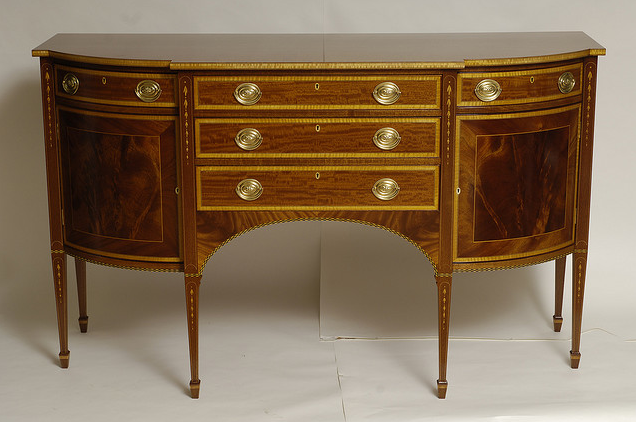If you are an antique pro wanna-be like I am, you'll know exactly what influence these chair backs are. One of my favorite designers is George Hepplewhite. A London designer and cabinetmaker, Hepplewhite made his mark in the 16th century. His furniture dates from 1780-1810 and is part of the Federal period in the United States. One piece that distinguishes Hepplewhite from any other designer is his shield-back chair which I adore. When I become a rich and famous designer, I will most definitely have six of these around my dinning table.
 |
| Obviously an imitation. |
Hepplewhite didn't just make chairs; he was a brilliant cabinet maker and his pieces can be found few and far between. He is credited with popularizing the sideboard and the short chest of drawers, NOT Chester Drawers. Please don't ever say that or else you will be laughed at. A lot. His designs for these pieces typically feature serpentine or bow-shaped fronts and tapered legs. So if you just happen to run across a piece that you think is Hepplewhite, there are a few minor details that you can check:
 Hepplewhite Style Legs: In contrast to the popular cabriole legs of the fabulous Queen Anne style, Hepplewhite pieces usually have straight legs. These can be square or tapered, and often have reeded or fluted edges, in imitation of Classical columns. Some chairs and sofas have H-stretchers, reinforcing pieces of wood that connect the legs to form the shape of an H.
Hepplewhite Style Legs: In contrast to the popular cabriole legs of the fabulous Queen Anne style, Hepplewhite pieces usually have straight legs. These can be square or tapered, and often have reeded or fluted edges, in imitation of Classical columns. Some chairs and sofas have H-stretchers, reinforcing pieces of wood that connect the legs to form the shape of an H. Hepplewhite Style Feet: Complementing the plain, straight legs of a chair or table, Hepplewhite-style feet are usually simple: a rectangular spade foot or a tapered arrow foot. Bracket feet are common on heavier pieces, such as chests, desks and bookcases.
Woods used: Because Hepplewhite furniture is characterized by contrasting veneers and inlays, pieces often contain more than one type of wood. Mahogany was the wood of choice, but satinwood and maple were also popular.
To read more about the history of Hepplewhite and see more distinguishing elements, click here.
Other Hepplewhite pieces:
Bowfront chest of drawers with serpentine detail and Federal antique brass drawer pulls.
Flame mahogany serpintine front buffet
Tall bed with tapered legs possibly maple wood finish
Sideboard with all of the Hepplewhite elements
Really good imitation of a four back Hepplewhite sette
A Hepplewhite-style chair I saw today, one of four, priced at about $485 a piece. No joke. The legs aren't typical of a Hepplewhite style so I am wondering what they were thinking pricing this so high. That's why isn't important to know the style you like and question people about it! Don't settle for an imitation piece if you're looking for the real thing; and especially not at this price. If this was less than $100, I would've appreciated it more.
That's enough of a history lesson for me, but I hope this enlightened you a little about furnishings from the past. The Hepplewhite look is a very chic and proper style that would look great in any home. One rule about antiques: DO NOT PAINT, RESTAIN, OR ALTER A PERIOD PIECE. It will devalue it and make it worth zero. If you don't care about it's value, which you should, then do whatever you want with them. :)
Have a great Tuesday!










No comments:
Post a Comment